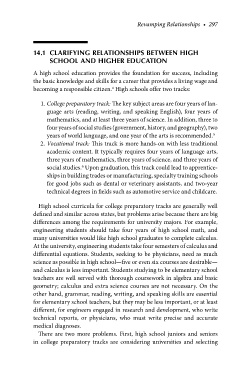Page 327 - Crisis in Higher Education
P. 327
Revamping Relationships • 297
14.1 CLARIFYING RELATIONSHIPS BETWEEN HIGH
SCHOOL AND HIGHER EDUCATION
A high school education provides the foundation for success, including
the basic knowledge and skills for a career that provides a living wage and
becoming a responsible citizen. High schools offer two tracks:
4
1. College preparatory track: The key subject areas are four years of lan-
guage arts (reading, writing, and speaking English), four years of
mathematics, and at least three years of science. In addition, three to
four years of social studies (government, history, and geography), two
years of world language, and one year of the arts is recommended. 5
2. Vocational track: This track is more hands-on with less traditional
academic content. It typically requires four years of language arts,
three years of mathematics, three years of science, and three years of
social studies. Upon graduation, this track could lead to apprentice-
6
ships in building trades or manufacturing, specialty training schools
for good jobs such as dental or veterinary assistants, and two-year
technical degrees in fields such as automotive service and childcare.
High school curricula for college preparatory tracks are generally well
defined and similar across states, but problems arise because there are big
differences among the requirements for university majors. For example,
engineering students should take four years of high school math, and
many universities would like high school graduates to complete calculus.
At the university, engineering students take four semesters of calculus and
differential equations. Students, seeking to be physicians, need as much
science as possible in high school—five or even six courses are desirable—
and calculus is less important. Students studying to be elementary school
teachers are well served with thorough coursework in algebra and basic
geometry; calculus and extra science courses are not necessary. On the
other hand, grammar, reading, writing, and speaking skills are essential
for elementary school teachers, but they may be less important, or at least
different, for engineers engaged in research and development, who write
technical reports, or physicians, who must write precise and accurate
medical diagnoses.
There are two more problems. First, high school juniors and seniors
in college preparatory tracks are considering universities and selecting

